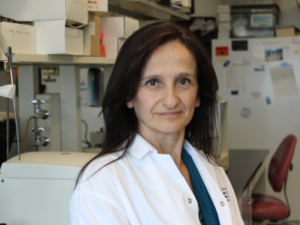Sep 7, 2021
Restore Vision 20/20 Research Awards: Developing Treatments to Restore Sight
In 2018 Fighting Blindness Canada (FBC) announced the first Restore Vision 20/20 research awards which support world-class research teams to develop therapeutic approaches for late-stage retinal degeneration, specifically retinitis pigmentosa (RP). Through the generous donation of Donna Green, her mother Goldie Feldman, and an anonymous donor, this $2.5 million project aims to move discoveries from the laboratory to the clinic, with the end-goal of initiating human clinical trials for new treatments.
Restore Vision 20/20 initially awarded $1.75 million to four world-class research teams to develop non-gene specific treatments for individuals with advanced retinal degeneration. The ultimate goal of these innovative treatments is to prevent further vision loss and restore sight.
We are now holding a second-round competition to award the remainder of the program’s funding to the team(s) that have shown significant progress and a clear plan to move their treatment toward the clinic. Applications are currently being reviewed by three expert reviewers from Canada and Germany. We look forward to announcing the results in the winter. In the meantime, we are excited to provide an update on the progress that has already taken place.
About the Restore Vision 20/20 Research Projects
Dr. David Gamm (University of Wisconsin): Studying Photoreceptor Cell Replacement Therapy for Late Stage Retinitis Pigmentosa (RP)

In the first two years of his project, Dr. Gamm has made impressive progress towards developing a cell replacement therapy for RP. In collaboration with Opsis Therapeutics, Dr. Gamm had previously developed a process to produce high-quality induced photoreceptor precursor cells (iPRP) from stem cells. iPRPs are a type of stem cell that are committed to forming photoreceptor cells. When transplanted into the eyes of rats, these iPRPs successfully integrated into the retina and developed into photoreceptor cells.
Using Restore Vision 20/20 funding, Dr. Gamm expanded this work into a large animal model. Experiments in larger animals provide more reliable information about how a treatment might work in humans and are important before agencies like the FDA (in the US) or Health Canada will allow a new treatment to be tested in humans in clinical trials.
This project has three aims:
Aim 1: Optimizing the surgical technique to inject iPRPs subretinally
Subretinal injections are already used to inject gene therapy into the retina. However, there are a number of unique challenges to safely injecting cells into the eye, because cells are much bigger (10,000x) than gene therapy (which are delivered in viral vectors). After testing a number of procedures, Dr. Gamm’s team developed an effective three-step process that allows cells to be injected into the sub-retinal space, prevents reflux of the cells out of the sub-retinal space and results in successful transplantation and integration of iPRPs with other cells in the retina.
Aim 2: Developing an effective immunosuppression protocol to support cell transplantation
One of the universal challenges of any cell replacement therapy is to ensure that the transplanted cells survive and aren’t rejected as “foreign” by the host’s immune system. That is why patients who are undergoing organ transplants are given drugs to suppress their immune system. In order to identify an effective and safe immunosuppression regime for the new animal model, Dr. Gamm worked with a veterinarian with expertise in immunology who identified a 3-drug combination, which was largely well tolerated and helped prevent cell rejection.
Aim 3: Does iPRP cell transplantation improve animal vision?
Dr. Gamm found that three months after transplantation, iPRP cells had developed into both rod and cone photoreceptors in the retina and importantly had formed connections with other (previously existing) retinal cells. These connections are crucial to allow the new photoreceptors to successfully send light signals to the brain. The team did note that iPRP transplantation did not always result in a consistent photoreceptor layer, with some areas of the retina having good thickness, and other areas being much thinner. The team also found some evidence that there was improved retinal function in eyes that had received treatment, but not in untreated eyes.
In the next stage of this project Dr. Gamm aims to test if iPRP cell transplantation restores functional vision in dogs using different vision tests and behavioral measurements. He will also test a new transplantation strategy with the aim of generating a more consistently thick and effective photoreceptor layer.
Dr. Richard Kramer (University of California, Berkley): Making Retinal Cells Light Sensitive with a Photo-Switch Drug

In RP, once photoreceptor cells die, the eye is unable to sense light even though the rest of the cells in the retina may be intact and healthy. Dr. Kramer has previously shown that a light-sensitive drug (BENAQ) can turn a specific type of retinal cell, called a retinal ganglion cell, into a light detector, bypassing the need for healthy photoreceptor cells. With funding from Restore Vision 20/20 he is trying to move these results towards a clinical trial.
The project has two complementary aims:
Aim 1: To identify and test the most effective BENAQ drug formulation
Dr. Kramer first tested different delivery agents and concentrations of the drug on retinal cells in a petri dish. Based on these experiments he identified an optimal formulation which was tested in an animal model. In these experiments, the drug was still present in the retinas of mice up to 28 days after treatment.
Aim 2: Develop a new animal model and test BENAQ
Dr. Kramer’s team has created a new mouse model that has retinal degeneration and engineered retinal ganglion cells that fluoresce when they sense light. This allows the team to use imaging techniques to study if BENAQ is turning retinal ganglion cells into light sensors. These experiments are currently being completed. Future studies will study the impact of BENAQ in larger animal models
Dr. Philippe Monnier (Krembil Research Institute): Developing a treatment to increase photoreceptor cell survival

Through a previous FBC-funded project, Dr. Monnier showed that blocking a protein called Neogenin increased photoreceptor cell survival. With funding from Restore Vision 20/20, he developed and tested a gene editing approach to block Neogenin in the retina of a larger animal model.
This project has two aims:
Aim 1: Identify the best gene editing approach to block Neogenin
In his previous experiments, Dr. Monnier used a small molecule to block Neogenin function. However, it would be hard to turn the molecule into an effective drug. Therefore, his team turned to gene editing as a way to reduce the amount of Neogenin in cells. Dr. Monnier’s team tested multiple gene editing approaches for their ability to reduce levels of Neogenin. The most successful gene editing treatment was packaged into a piece of DNA called a vector so that it could be delivered as a gene therapy.
Aim 2: Test Neogenin shRNA therapy in large animal model
The gene therapy to block Neogene was injected into the eyes of a large animal model that had a mutation in the PDE6B gene which causes RP. The injections were shown to be safe. Unfortunately, the gene therapy did not increase the survival of photoreceptor cells. In future work, Dr. Monnier will explore alternative treatment approaches to block Neogenin to try and preserve photoreceptors.
Dr. Catherine Tsilfidis (Ottawa Hospital Research Institute): Stopping photoreceptor cell death in retinitis pigmentosa (RP)

Dr. Tsilfidis is testing a universal gene therapy approach to try and preserve retinal function in RP. Dr. Tsilfidis has previously shown that introducing a molecule called XIAP (X-linked inhibitor of apoptosis) into photoreceptor cells of mice with retinal degeneration can slow disease progression. Dr. Tsilfidis is using funding from Restore Vision 20/20 to test the XIAP gene therapy in a larger animal model of retinal degeneration.
Dr. Tsilfidis’ experiments have been delayed by COVID-19 but are now starting to move ahead. She will be testing two different delivery vectors for the XIAP gene and measuring if retinal cells survive better after treatment with the gene therapy by measuring retinal cell thickness and activity. Future work will include generating high-grade vectors which are appropriate for use in clinical trials and completing more safety and dosage studies.
These projects are pushing the boundaries to develop innovative treatments for advanced retinal degeneration. Stay tuned to learn more about the next stage of the Restore Vision 20/20 award program!
Learn about other FBC-funded research projects.

Join the Fight!
Learn how your support is helping to bring a future without blindness into focus! Be the first to learn about the latest breakthroughs in vision research and events in your community by subscribing to our e-newsletter that lands in inboxes the beginning of each month.

